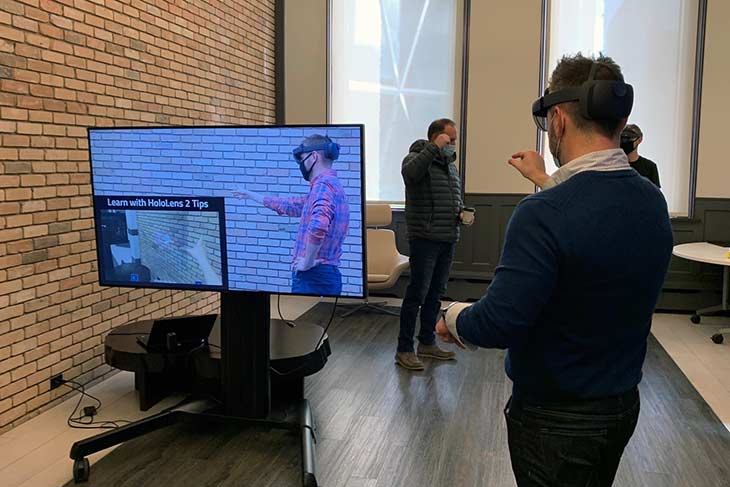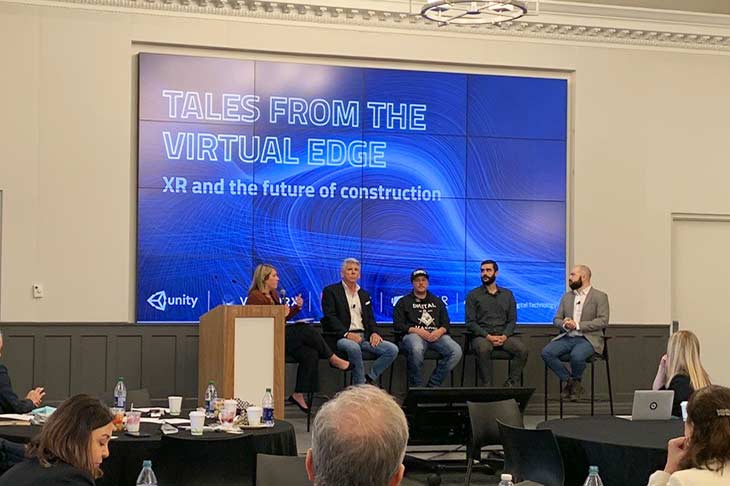Construction collides with advanced digital technology

Tales from the Virtual Edge is an event series hosted by the School for Advanced Digital Technology to explore emergent digital technologies shaping the future of our world.
“A career in construction isn’t just about building, it’s about building the future.” -Jim Gibson, Chief Catalyst, School for Advanced Digital Technology.
The first installment of the Tales from the Virtual Edge drew a community crowd of industry, faculty, staff and students to SAIT’s downtown campus last week to talk extended reality (XR) and the future of construction.
Spurred by a new collaboration between SAIT’s School for Advanced Digital Technology (SADT) and School of Construction, the event was a technology showcase for industry leaders in the construction and XR sector and an opportunity to share ideas, explore collaborations and experiment with the tech by donning a Microsoft HoloLens headset.
Building the future
“Our mission in the School of Construction is to support the industry in advancing field construction practice — using technology is a way to do that,” says Reva Bond Ramsden, Dean, School of Construction. “With a labour shortage predicted, and amplified by the pandemic, there’s also an opportunity to use that same technology to attract new talent into the field of construction.”
Experimenting with embedding digital experiences — such as 3D modeling and mixed/augmented reality — alongside traditional hands-on learning to teach certain trades has been at play in the school for more than a decade.
Incorporating XR allows more time training in an environment that replicates being on the job site, no matter where a student is. Through this approach, faculty have noted improvements in knowledge retention and skills execution in the physical world.
📺 WATCH Pipetrades instructor Fred Bretzke believes the future of teaching construction is digital
“Working in this interdisciplinary way with our colleagues in SADT and industry partners has helped us advance where we’re headed,” says Ramsden. “With a new suite of HoloLens and Oculus headsets, we can take what we’ve been doing with XR one-on-one with a student or apprentices and deliver it to a whole class.”
Accumulating voices to accelerate ideas
Bringing together people and ideas to accelerate the development of a local, digitally competitive workforce is a strategic priority for SAIT and a core purpose of SADT.
“To me, this is a collision — the world of construction meets the world of advanced digital technology,” says Jim Gibson, Chief Catalyst, SADT.
“What’s important is that we create a place where people can touch and learn with technology together. We want this building to light up downtown. That’s what this place is all about.”
If you missed the first installment of Tales from the Virtual Edge, learn a little about XR and the future of construction from some of Alberta’s leading industry voices with these takeaways.
The panel
- Unity Technologies | Nick Facey, Lead, Industry Solutions
- Onsite3D | Wade Eno, President and CEO
- PCL Construction | Giancarlo Da Silva, Manger, Integrated Construction Services
- Serious Labs | Jim Colvin, President and CEO

How is the gaming experience a driver to XR, you, your business? 🕹️
WE: Video games is where XR comes from. I’m obsessed with technology, and this is the latest and greatest. As a kid, immersing yourself in a different environment inspired you and challenged you to constantly level up. As an adult, you head out to work and apply that philosophy to practical applications.
JC: People learn by doing. We infuse video game components into simulator training, for example, training on a forklift at height carrying a load. I always use the example of Angry Birds. If you think about it, Angry Birds teaches you more about thrust, trajectory and gravity than a Grade 11 physics class.
NF: Deep down I’m a nerd. Taking video game technology into industrial solutions isn’t fully realized. I’m good at things that motivate and interest me and that pushes me into technology and innovation not just to do something first but to do it right.
Why isn’t XR further along? 💻
GDS: The barrier for entry is pretty high. You need to have the skills to create the model and hardware that’s powerful enough, and there’s a lack of content. VR is excellent and it’s growing a lot, but it’s not widely consumable by the vast majority yet. When the practical applications of this technology are ready to use right away by industry, it will really take off.
JC: You need computer power and people building projects to put inside of these worlds. Head-mounted display is the game changer. Technology has to converge with you, with the industrial world. That’s what will drive it. It can’t be complex, it has to be intuitive.
NF: One of the VR/XR challenges is more data. We keep maxing out what we can transmit. The data problem needs to be addressed. It’s a near-term jump that needs to happen.
What does the future of construction look like? Who’s missing from the equation? What skills and competencies are needed?🏗️
GDS: Flexibility. Things are changing so quickly. An interest in tech — a passion. Looking to the future, a contract is about communicating information. If we can remove barriers by having someone put on a pair of glasses or incorporate changes into what someone is seeing in real time, that’s value.
NF: Enabling people to be more creative, to do the things they’re good at, is actually one of technology’s super powers. Not everyone needs to be an engineer or a developer to have an incredible career in this ecosystem. The career paths that technology will make available — I can’t imagine what careers will be out there.
JC: I’m fascinated by where the world is going but more by how to get there. We need to collapse the time to competency and job site readiness, through things like micro-credentials, so people can walk out of a simulator and into the real world ready to work. We also have to meet people where they are — new Canadians, Indigenous communities, women and other underrepresented groups. We’re going to have a labour shortage in the industry — our workforce depends on us being more inclusive.
WE: Boots on the ground. Putting the tech in the hands of people on the ground. That’s the biggest thing, and the safety side of things. I work in an environment that is very resistant to change. As an industry leader, I’d like to create an open forum to ensure the skillsets of the older generation get handed down to the next. Everyone wants to own technology, so they don’t include others. We need to make it more available to people. SAIT is providing that platform through SADT.
Tales from the Virtual Edge is hosted by SAIT’s School for Advanced Digital Technology and Unity XR.
Skills for the Future
We prepare students for successful careers and lives.
SAIT'S
2020-2025
Strategic plan

Oki, Âba wathtech, Danit'ada, Tawnshi, Hello.
SAIT is located on the traditional territories of the Niitsitapi (Blackfoot) and the people of Treaty 7 which includes the Siksika, the Piikani, the Kainai, the Tsuut’ina and the Îyârhe Nakoda of Bearspaw, Chiniki and Goodstoney.
We are situated in an area the Blackfoot tribes traditionally called Moh’kinsstis, where the Bow River meets the Elbow River. We now call it the city of Calgary, which is also home to the Métis Nation of Alberta.